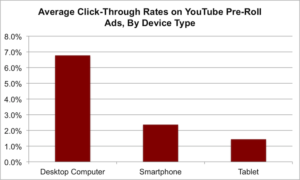How Mobile Changes Ad Viewership on YouTube | Part 2
Last week, I discussed how the shift in viewing behavior has had a huge impact on online video consumption. This week we will look at how YouTube ads work differently on mobile devices and share recommendations for YouTube marketers who want to optimize their strategy for mobile.
Mobile viewers skip ads more often
Our analysis of YouTube ad campaigns showed that view rates (the percentage of fully watched, unskipped ads) was about 26% lower on mobile devices when compared to desktops.
There are two possible reasons for this: Many people use YouTube on desktop computers as a virtual jukebox to play music videos in the background, never skipping ads while doing that, which drives up view rates artificially. This form of usage is rarely seen on mobile devices because they can’t play videos in the background. Another reason might be that the more conscious selection of content on mobile devices makes viewers more likely to skip ads in order to get to the desired content quickly.
Ad rates are about the same across platforms
Most YouTube campaigns are charged on a Cost per View (CPV) basis. We did not find significant differences in CPVs between desktops and mobile platforms. To some extent this is surprising because there is less mobile ad inventory, and a higher level of competition for ad space typically leads to higher CPVs. In fact, we saw somewhat higher CPVs in some industries that have a particularly high share of mobile views, such as fashion.
Click-through rates are much lower on mobile devices
One of the possible goals (but not the only one) of a YouTube campaign can be to get viewers to click on the ad, taking them to the advertiser’s website. In this respect we found a dramatic difference between desktop and mobile viewing: Smartphones showed a 65% lower click-through rate, and tablet clicks were even 79% lower.

The most plausible interpretation is again that the very different mode of using these devices makes users reluctant to click away from the video content they are about to watch. Going back to the main video after a click to the advertiser’s website is very easy on a desktop PC, but a hassle on a phone or tablet, so an ad has to make a really compelling case. We saw the highest click-through rate on video ads that got to the point quickly, made a strong promise and had a clear call to action.
Another reason for low click-through rates is that the clickable elements on YouTube’s mobile apps are less obvious and available than on the desktop. For example, a clickable banner stays visible after the ad plays on the desktop, but disappears on mobile.
Recommendations for YouTube marketers
Our preliminary results suggest that viewer behavior on mobile devices is quite a bit different. Mobile viewers seem to watch video content with more focus and have less tolerance for interruptions.
What this means for marketers:
1. Focus even more on producing content that people really want to watch. Mobile viewers are picky, but once they start watching a video they are sticking with it.
2. Make ads that start fast and make a clear promise. Mobile viewers are quick to click away if they don’t see immediately why they should watch an ad.
3. Optimize your channel experience for mobile viewers, focusing on iOS and Android. One key aspect is to manage a YouTube channel’s subscriber feed because that’s what users of YouTube’s mobile app see first. Investing into playlist creation and video SEO are other crucial factors. iOS and Android are the only mobile platforms that matter at this time.
4. A/B test systematically. Mobile viewer behavior patterns are just emerging, YouTube’s mobile apps keep changing, and that’s why there are many surprises in how people react to content. Testing different variations of ads and SEO approaches is worth your time.